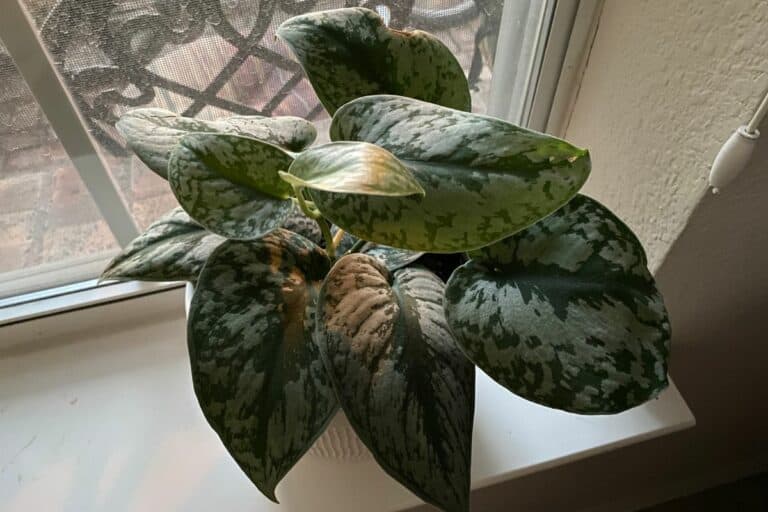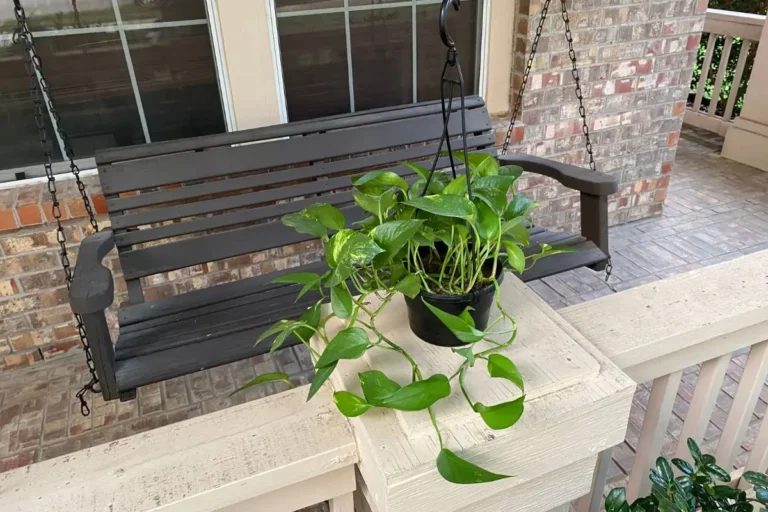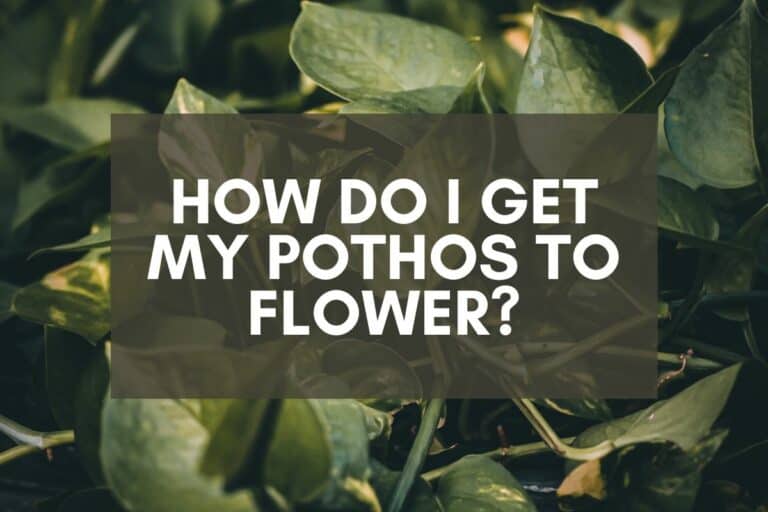Where Should I Put My Pothos? 5 Things to Consider
Several years ago, when I decided to buy my first pothos plant, I was so excited to bring it home and find the perfect spot for it.
But as I brought it inside and started looking around, I realized I had quite a bit to learn about raising houseplants right. The first question that came to mind was: Where should I put my pothos?
As a general rule, pothos plants prefer bright, indirect light and warm, humid climates, so the best places to put them are near east- or northeast-facing windows or in well-lit bathrooms and away from areas where temperatures get too high or low, such as drafty doors or near heaters and fireplaces.
Of course, pothos are known for being some of the most forgiving houseplants out there, and they’ll survive almost anywhere in your house, but to keep your plants truly happy, certain places are more conducive to growth than others.
I’ve had pothos plants in my house for 10+ years, so what I’d like to do in this article is answer 5 of the most common questions regarding the placement of your pothos:
- What’s the best environment for my pothos?
- Do pothos plants need to be by a window?
- Should pothos hang or climb?
- Can pothos survive outside?
- Where should I avoid putting my pothos?
Read on to learn everything you need to know about raising a happy pothos houseplant!
What Are the Best Conditions for My Pothos?
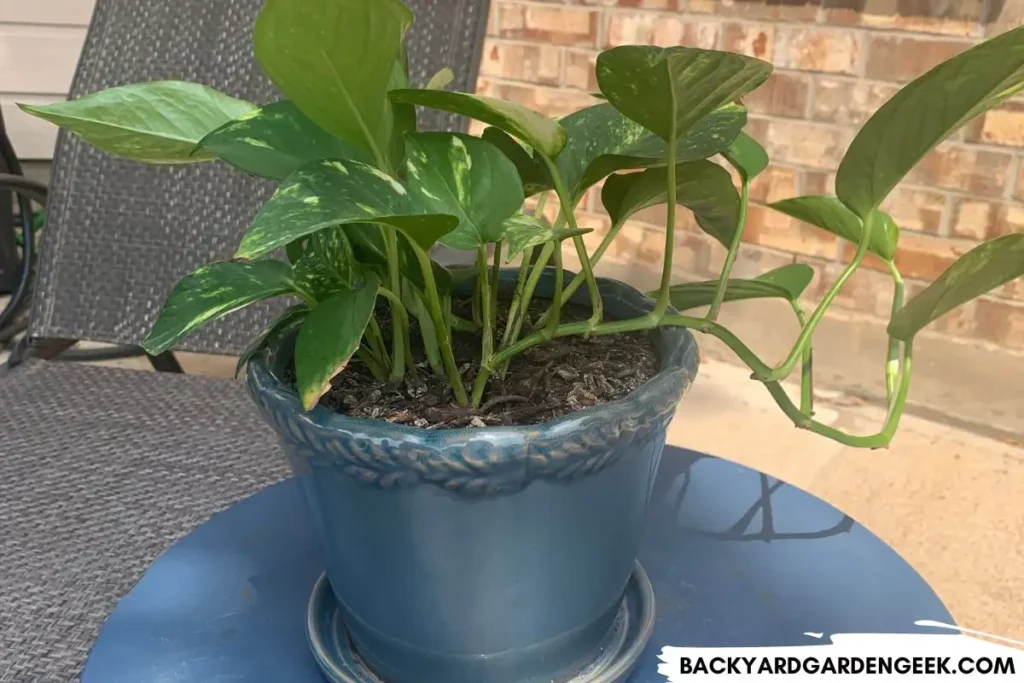
In general, I’ve seen pothos plants survive in some of the toughest conditions—including the sad, window-less bathroom at my office that gets no natural light. These plants are resilient!
But while pothos plants can survive in most indoor conditions, they’ll do best if you provide them with the conditions that’ll help them grow into healthy, beautiful plants.
In terms of light, pothos prefer bright, indirect light. A cozy spot near an east- or northeast-facing window is ideal since they can bask in partial sunlight.
I like to shield them from direct exposure to intense, direct sunlight though, as excessive sunlight can lead to leaf damage. If you start to notice brown, crispy leaves, move your plant to a location that gets less direct sunlight.
When it comes to temperature, pothos love a warm, comfortable environment. If you feel comfortable in your house, your pothos probably does too. Maintaining a temperature range of 60 to 85°F (15-29°C) will keep your pothos content and flourishing.
Try your pothos out in a few different locations before deciding which one works best, keeping in mind the amount of light during different times of day and avoiding spaces that might have extreme fluctuations in temperature (such as air conditioner vents or fireplaces).
And of course, find a spot for your pothos that you find aesthetically pleasing. You should place your plant in a spot that will make the pothos happy, but its location should also make you happy!
Should My Pothos Be Near a Window?
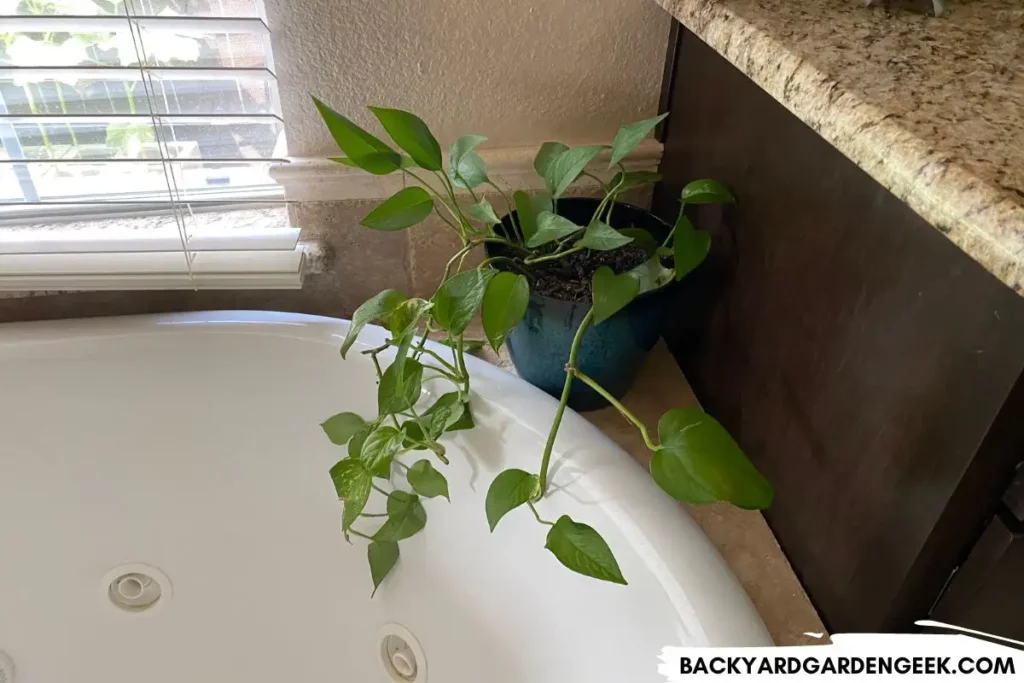
I love placing plants in front of my windows for aesthetic reasons, but placing your pothos near a window is also highly practical as it allows the plant to receive ample natural light if the window faces the right direction.
When placing your pothos near a window, make sure that it gets several hours of gentle sunlight and that it’s not exposed to hot direct sunlight or cold wintry drafts.
Finding the right balance is key. Direct exposure to intense sunlight can harm pothos leaves, leading to sunburn and discoloration. In such cases, you may want to save your prime window spots for plants that prefer harsher, direct light such as jade plants or jasmine.
I recommend keeping your pothos a few feet away from any windows that get too much direct sunlight or use sheer curtains or blinds to filter the sunlight. This way, the plant receives the benefits of natural light without being subjected to its potentially harmful effects.
The direction the window faces also plays a role in determining the ideal placement for your pothos. Northeast- and east-facing windows provide gentle, indirect light, making them suitable spots for your pothos.
Since south- and west-facing windows receive more direct sunlight, especially during the peak hours of the day, you should keep your pothos further away from these windows or provide some form of shading.
Another factor to consider when it comes to window placement is outdoor temperatures. If you live in a region with extreme temperatures—like I did when I lived in New Jersey (where winters are extremely cold) or now that I live here in North Texas (where summer temperatures ar extremely hot)—you’ll want to keep your pothos plants a few feet away from your windows.
Extreme temperatures can stress your pothos and affect their overall health, but as long as you shield your pothos a bit, your plant will survive the winter months and do just fine in summer as well.
Please note that it’s all about finding the sweet spot in your home where your pothos can enjoy sunlight without getting too much of it. Don’t be afraid to try your plant out in a few different locations to see which one it likes most!
Should I Let My Pothos Climb or Hang?
I have pothos plants all over my house, but my favorite one hangs in my entryway. The hanging vines greet me every time I walk into my house, and that little bit of greenery is nice to see after a long day at the office.
Pothos plants are versatile, and they’ll do well hanging, climbing, or simply cascading over the edge of a pot. Choosing a pot or structure for your plant comes down to personal preference and your available space.

When deciding whether you’d like to encourage your pothos to hang or climb, consider a few factors:
- How much vertical space do you have?
- Can you reach your pothos easily for watering and occasional pruning?
- Is it in a relatively safe location in terms of children and pets?
First, consider your space. If you have limited floor or wall space, you can suspend your pothos from the ceiling, place it on a high shelf, or use a hanging planter to let the vines dangle freely.
On the other hand, if you’ve got room for your pothos to grow vertically, much like they do in their natural tropical environments, you can provide a trellis, moss pole, or other climbing support to help it grow up your wall.
Another factor to consider is maintenance. Climbing pothos may require occasional pruning and training to guide the vines. Hanging pothos, on the other hand, may require pruning as well so that their vines don’t end up on the floor or within reach of your furry friends.
Keep an eye on the moisture levels and adjust your watering routine accordingly. And if you hang your plant out of reach, you’ll have to pull out that step ladder every time you need to water.
Ultimately, the choice between hanging or climbing boils down to personal preference and the specific characteristics of your space. There’s no right or wrong answer here, so just trust your instincts and create an environment that suits both your style and the needs of your pothos.
Can I Put My Pothos Outside?
You might have considered bringing your indoor pothos plant outdoors during the nicer seasons of the year, so here’s a quick overview of the pros and cons of bringing pothos outdoors.
Pothos plants are resilient and can adapt to different environments, but in most areas of the world, it’s primarily an indoor plant. However, you can bring it outside for a temporary change of scenery if you take the time to care for it properly.
If you’re longing to add a little pothos greenery to your outdoor living spaces, here are a few things to consider:
First, keep in mind that pothos plants are native to tropical regions and thrive in warm, humid environments with filtered light. When considering where to place your pothos outside, make sure the conditions mimic their natural habitat as closely as possible.
If you live in a region where temperatures remain consistently warm and humid, your pothos may enjoy a temporary outdoor stay during spring, fall, and possibly even summer.
Just remember that prolonged exposure to intense sunlight can scorch its delicate leaves, leading to damage and stress. Find a spot with dappled or indirect sunlight, such as under a tree canopy or on a covered patio, and make sure your plant is well-watered.
Keep a close eye on the weather as well. If there’s a chance of extreme temperature fluctuations, heavy rains, or strong winds, you’ll want to bring your pothos back indoors.
Sudden temperature fluctuations or harsh weather conditions can shock and harm your plant. Your pothos plants are likely accustomed to controlled indoor environments, so it may be more vulnerable to outdoor elements.

Finally, keep in mind that pests and plant diseases are more prevalent outdoors. Aphids, mealybugs, and spider mites can quickly latch onto your pothos and cause damage, so you’ll need to regularly inspect your plant and take appropriate measures to prevent infestations.
I’ve had lots of experience fighting off aphids, spider mites, and other garden pests, so if you’d like to learn more about the best ways to do so, check out these related articles:
- 11 Proven Ways to Stop, Kill, and Get Rid of Spider Mites
- Can Plants Recover from Aphids? Tips to Save Your Plants
- Can Plants Recover from Spider Mites? What You Need to Know
- Can You See Aphids on Plants? Spotting Early Infestations
- Using Neem Oil to Kill Spider Mites: A Complete Guide
Long story short, while pothos are primarily indoor plants, you can temporarily introduce them to the outdoors with proper thought and care.
Where Should I NOT Put My Pothos?
Did you know that, if ingested, pothos are toxic to both people and pets? Their leaves and stems contain calcium oxalate crystals, which, when chewed or consumed, can cause discomfort and irritation in the mouth and throat.
Although I’ve placed pothos within reach of my children and have never had an issue, many kids are curious about plants, as are some dogs and cats, so it’s best to keep your pothos in areas that are inaccessible to curious little hands and paws. Opt for elevated shelves or hanging planters to ensure the safety of your kids and pets.
On that note, you should avoid placing your pothos in bedrooms or playrooms where children or pets may spend extended periods of time. This reduces the chances of accidental contact or ingestion.
Opt instead for locations that are less frequented by your little ones and furry friends, such as living rooms or adult-only spaces.
When it comes to pets, some animals like to chew on plants, and pothos can be particularly appealing due to their dangling vines. Cats, in particular, are known to be curious nibblers. To protect your pets, keep your pothos in an area where they can’t access them, like high shelves they can’t reach or jump to or rooms that are off-limits to them.
In other words, the best spots for pothos plants are areas that get bright, indirect light, few or no extreme temperature fluctuations, and out of reach or inaccessible to children and pets.
Once you’ve found the ideal spot, water your plants regularly to keep the soil from drying out, and you’ll have a happy, healthy pothos plant!
Further Reading
If you’re interested in learning more about caring for pothos plants, you might enjoy these related articles:

